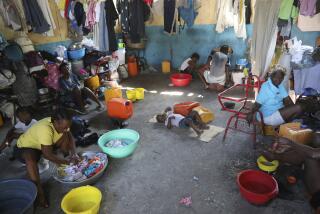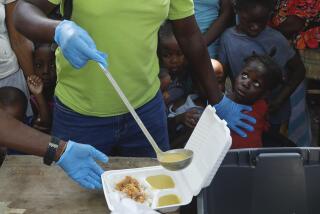Hunger kills hundreds of kids in Ethiopia’s Tigray region, report says

- Share via
ADDIS ABABA, Ethiopia — At least 1,900 children under 5 have died from malnutrition in Ethiopia’s embattled Tigray region in the last year, according to a study conducted by regional health officials and seen by the Associated Press.
The deaths were recorded at health facilities across Tigray between June last year and April 1. Western Tigray, which is under the control of forces from the neighboring Amhara region, was not included in the survey.
A doctor involved in the study said the true number of child deaths from malnutrition is likely higher as most families are unable to bring their children to health centers because of transportation challenges. Most hunger deaths go unrecorded, he said.
“Because we cannot access most areas, we do not know what is happening on the community level,” said the doctor, who requested anonymity for fear of reprisals. “These are simply the deaths we have managed to record in health facilities.”
Tigray has been cut off from the rest of Ethiopia since June when fighters from the Tigray People’s Liberation Front, or TPLF, recaptured most of the region as federal forces withdrew.
Banking services, phone lines and road links are all down in the region, a situation the United Nations has said amounts to a “de facto blockade.”
Ethiopian authorities insist there is no deliberate effort to target Tigrayan civilians. They have urged Tigrayan fighters to surrender.
More than 90% of Tigray’s 5.5 million people require humanitarian assistance, including 115,000 children who are severely malnourished, according to U.N. figures.
Civil servants have not been paid in months. Many have run out of cash to buy food and other goods because banking services have been shut down. The children of families living in urban areas are especially at risk of malnutrition, as their parents don’t have farmland to grow food, Tigrayan health officials say.
Around 700,000 people in Tigray are in the grip of “famine-like conditions” due to the obstruction of aid, U.S. officials estimate.
Ethiopia’s federal government unilaterally declared a surprise “humanitarian truce” on March 24, an announcement it said would allow aid to flow into Tigray. But nearly one month later, only four convoys of around 80 food trucks have entered the region.
“Literally nothing has changed,” said an aid worker who recently visited Tigray. “We are just seeing a handful of trucks; these trucks are better than nothing but they are not going to feed the millions of people who need aid” in Tigray.
An estimated 2,000 trucks of food must enter Tigray every week to meet the region’s needs, a U.N. official said at a meeting in Nairobi, the Kenyan capital, on Wednesday, according to the aid worker, who attended. That’s a sharp increase from the previous assessment of 600 a week. The aid worker also spoke on the condition of anonymity for safety concerns.
Just 3% of the vegetable seeds and 10% of the fertilizer required for the current planting season have reached Tigray, according to U.N. figures, raising fears of a poor harvest that would deepen the region’s hunger crisis.
Some health officials in Tigray say they simply don’t have enough supplies to treat many patients they encounter. Some who recently spoke to AP said shortages are so dire that some patients’ relatives must personally buy medicines from private pharmacies at inflated prices and bring them to the hospital before their family members can be treated.
Tens of thousands of people have been killed in the war, according to estimates by international aid groups.
But there is little hope for peace talks as Ethiopian authorities have outlawed the TPLF, effectively making its leaders fugitives on the run.
More to Read
Sign up for Essential California
The most important California stories and recommendations in your inbox every morning.
You may occasionally receive promotional content from the Los Angeles Times.










